The bright stage lights, the exhilarating roar of the crowd, the electrifying energy flowing through the room – all create the perfect setting for an unforgettable guitar performance. However, hidden behind the display of talent and charisma, lies a technological component, often overlooked yet incredibly influential – the guitar rack effects. This unassuming piece of gear housed an assortment of effects processors, shaping the iconic sound that left a lasting impression on the audience that night.
Welcome to the world of guitar rack effects – a realm rich with sonic possibilities. From the silky-smooth reverbs to the thick chorus complementing the crisp crunch of overdriven tubes, these effects encompass a universe of tones at your disposal. But how do we navigate this cosmos of sound variations? Enter ‘The Comprehensive Guide to Guitar Rack Effects’ – your in-depth roadmap to mastering guitar rack effects.
My name is Edward – a long time enthusiast of guitar rack effects and former editor in chief of Guitar Player magazine. Over the years, I have had the chance to observe and influence the evolution of guitar sound technology. I’ve experimented with a wide range of effects processors, savored the profound alterations in tone they can create, and experienced the nuances that differentiate a live concert setup from a recording studio one.
My journey was not without its pitfalls, but each one provided a valuable lesson. Now, I am eager to share my insights with you to help you wield these potent tools, to inspire you to explore new sonic territories, and to understand how these machines can magnify your expression, both on stage and in a studio setting. Together, we’ll delve into the labyrinth of guitar rack effects, unlocking their secrets to help you find your unique voice.
So, whether you’re a complete newbie seeking to understand the basics of guitar rack effects, a seasoned musician aiming for a new tone, or a gear aficionado craving for more knowledge, this guide is for you. Buckle up and let’s embark on this enthralling journey together.
Guitar Effects History
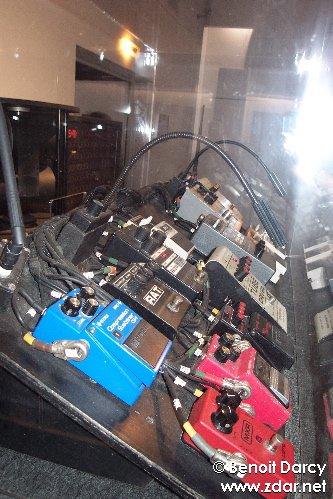
As I embarked on my journey within the ever-evolving guitar industry, my fascination with guitar effects history was sparked. It was a world filled with innovation, creativity, and the unending quest to coax new sounds out of the humble guitar. From the basic amplifier effects of the 1950s to the complex multi-effects processors of today, the history of guitar effects is a captivating narrative of musical technology amplifying human expression.
Like chapters in a great novel, the development of guitar effects unfolded one era at a time. Initially, guitar effects were simple and rudimentary like tremolo and reverb, ingrained directly onto the amplifier. This brings us to something fascinating, did you know the earliest guitar effects were constructed in the amplifier itself? Such a revelation sparks a sense of awe. Guitar effects history was not always marked by stompboxes and rack effects. The inception was in the amplifier, offering the player a world of creative possibilities within a simple twist of a knob.
By the 1960s, stand-alone effects started to gain popularity. Units like the Maestro Fuzz-Tone captured the hearts and ears of many guitarists. I fondly remember the first time I experimented with a fuzz pedal, the rich, distorted sound and the excitement of discovering a fresh wave of tonal possibilities. Its popularity exploded after it was famously used in the Rolling Stones’ hit ‘(I Can’t Get No) Satisfaction,’ marking a pivotal moment in guitar effects history.
Then came the 1970s and 1980s, introducing a surge in the use of rack effects. Customizable, sleek, and more advanced, they rapidly found their place in professional touring and recording instances. I recall the first time a rack multi-effects processor caught my eye. Its complex-looking interface, a myriad of features, and the intimidating promise of endless sound possibilities drove me towards the captivating world of rack effects. This was the era where our beloved guitar sounds started being taken over by technology, changing the trajectory of guitar effects history utterly and irrevocably.
Moving into the digital age, guitar effects began to take on new forms. Software plugins, smartphone apps, and advanced multi-effects units emerged, offering even more versatility and ease of use. Today, we have a combination of all these eras at our disposal, allowing for an unprecedented range of options for guitarists to discover, explore, and redefine their sound.
After decades in this industry, it always amazes me how much we’ve developed within the realm of guitar effects. Yet, at the same time, how much we’ve managed to preserve as well. The innovation of yesteryears is encapsulated within the technology of today, layering the new with a sprinkle of the old. This continuous interplay and evolution create a rich tapestry, one that weaves the entire guitar effects history into a mesmerizing narrative.
So as we transition to understanding and using rack effects, remember that we are stepping into a rich, immersive history—a history filled with delightful learning opportunities and awe-inspiring breakthroughs that have sculpted and influenced the guitar sounds we love today. I invite you to join me as we unearth the magic of rack effects, an important chapter in our broader exploration of guitar effects history.
Understanding and Using Rack Effects for Guitar
Setting Up Your Guitar Effects Rack
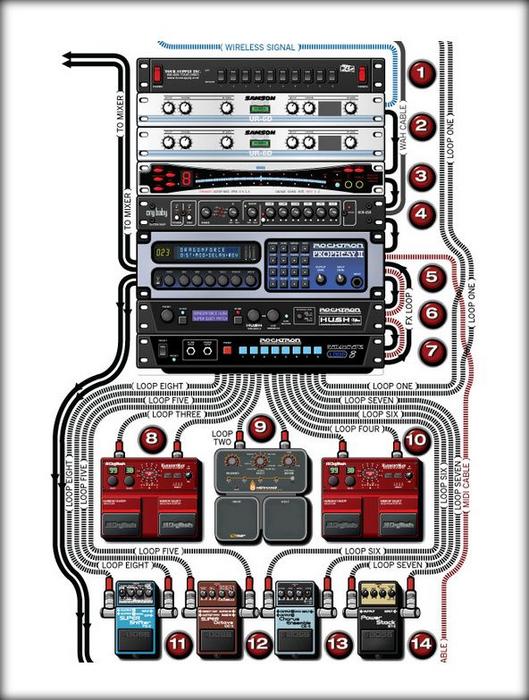
Mastering your guitar signal processing involves the clever use of guitar rack effects. Over the years, from making my first guitar rack setup to helping other musicians design theirs, I’ve learned a thing or two about this process. Here, I’ll share my expertise and insights on setting up your guitar effects rack – an essential part of understanding and using rack effects for the guitar.
First, let’s square off the basics. You need to begin by figuring out your desired sound. Which band’s sound do you resonate with? What specific guitar tone are you itching for? These questions will help you determine the type of effects you’ll need.
Next, familiarize yourself with the signal flow of your guitar effects setup, the bedrock of stellar guitar signal processing. A simple rule to abide by? Run time-based effects (like reverb or delay) behind distortion or overdrive effects. This helps to maintain clarity in your overall tone.
We can’t gloss over the indispensable entry and exit points of your signal: the Input and Output modules. These modules are vital to balance the impedance for optimal sound clarity. Not to mention, the output section should match the inputs of your sound systems (like your mixer or PA speaker).
Don’t forget the equalizers (EQ). EQs fine-tune your tone to ensure you cut through the mix. You can use it before the amplifier for tonal shaping or after for frequency cuts or boosts.
Then, there’s the careful arrangement of effects. Depending on the complex interplay between effects, their placement within the signal chain can drastically change your guitar’s sound. Remember, experimentation is your friend here.
Finally, you’ll need a good rackmount tuner. These ensure that wherever you go, you can accurately tune your guitar with ease.
And there you have it- some insightful tips on setting up your guitar effects rack. The key is to understand the intricacies, experiment with settings, and shape your unique tone. As we forge ahead to delve into the practicalities of using rack effects in live performance versus the studio, bear in mind the insights and principles we’ve discussed in this section. Remember, the guitar rack effects setup can make a world of difference to your sound.
Rack Effects in Live Performance vs Studio
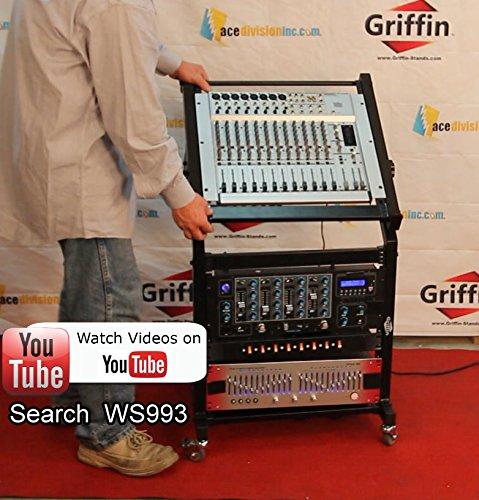
As we delve deeper into the realm of rack effects, an essential factor to understand is the differentiation between using them in live performances vs. the studio. Both scenarios necessitate unique approaches to optimizing your rack effects setup, and this knowledge can be instrumental in achieving the desired sound.
When it comes to studio rack effects, detail, precision, and the ability to tinker with settings are paramount. Studios are calmer and more controlled environments where you can push your experimentation to the fringe and craft the depth and texture of your melodious creations. You have time, and you can use it to adjust the smallest parameter until you find that sweet spot. The real beauty of rack effects resonates in this space where you can keep refining your sound without the pressure of time or audience.
In contrast, the application of live performance guitar effects calls for simplicity and reliability. In a live setting, you have to be able to change sounds swiftly between songs and sometimes in the middle of songs. Your choice and setup should allow smooth transitions and quick tweaks mid-performance. There’s little room for error or equipment malfunction. Therefore, the rigidity and durability of rack units shine here. The resilience, road-worthiness, and the ability to save, recall, and easily switch between presets make them a massive advantage.
There’s also an interesting difference in the audience interaction aspect in both contexts. In a studio environment, it’s mostly about pleasing your ears and fulfilling your creative vision. However, live performances demand that your sound must stand out and cut through the mix, ensuring that every note reaches the listener as intended.
As someone who’s been in countless gigs and studios, balancing and tailoring your guitar rack effects needs to the demands of the respective settings is an art in itself. The uniqueness of both environments presents different challenges and opportunities in tonal shaping. My experience has taught me the importance of understanding these parameters deeply, which in turn has leveraged my ability to make impactful musical infusions. So, whether it’s the intimacy of the studio or the raw energy of a live performance – the nuanced application of rack effects can enable you to deliver a distinctive and impressive tone.
The subsequent sections will provide more comparative insights into rack effects and pedals, along with their pros and cons. So, read on to deepen your understanding and make informed choices in your quest for the ultimate guitar tone.
Comparing Rack Effects with Pedals
Advantages and Disadvantages of Rack Effects and Pedals
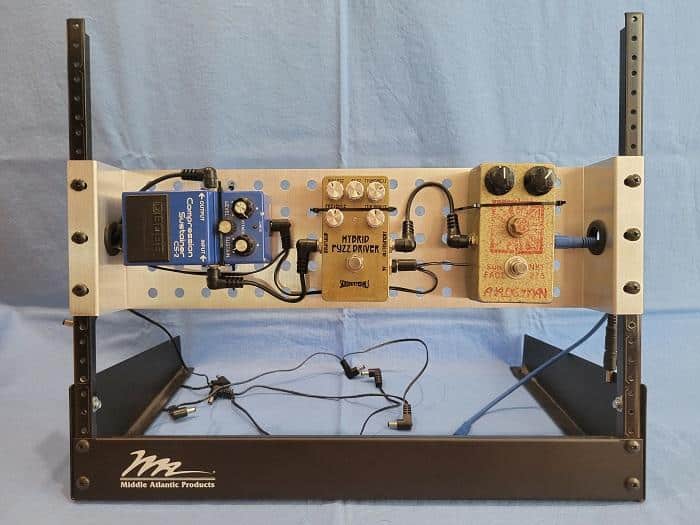
Throughout my career strumming the six strings, my journey has led me to dissect the nuanced arena of rack effects vs. pedals. Both hold their unique advantages and disadvantages, profoundly influencing the tone and character of your sound.
Rack effects are renowned for their detailed control, superior sound quality, and advanced features. As such, they are a staple in professional studio settings. However, their complexity can be off-putting, especially for novices. Moreover, they are considerably bulky, making them less portable. Their cost, due to their sophistication and superior quality, is also typically high.
On the other side of the stage, pedals offer immediacy, simplicity, and portability, making them popular in live performance settings. They provide tactile feedback, allowing on-the-fly changes during performance – a maneuver not easily executed with rack systems. However, their downside lies in their limited sound shaping capacity and in some cases, compromised sound quality especially on the lower end spectrum.
Hence, in this intricate dance of rack effects vs. pedals, your choice is steered by the context of use, your level of expertise, and your resources. Like the ebb and flow of a performance, these two systems can and do complement each other in many setups. It’s a trade-off between control and simplicity, quality and affordability, sophistication and immediacy – a trade-off that’s become the rhythm behind the music we create.
As you continue to navigate this guide, I encourage you to think of them less as adversaries and more as partners, harmonizing your sound through their unique contributions. The spotlight is truly on how you choose to play out this duet. Remember, a mastery of this knowledge isn’t just theoretical – it’s a praxis lived through personal exploration and expression on the fretboard.
Spotlight on Popular Guitar Rack Effects
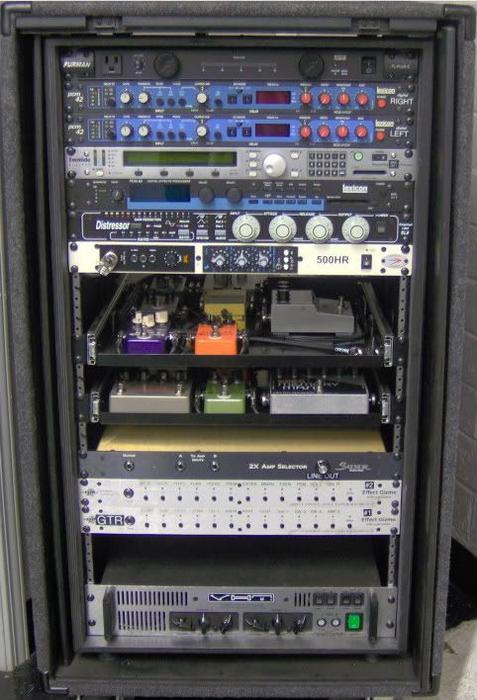
Gaining insightful access into the unfiltered world of professional guitarists’ gear is akin to having your very own musical treasure trove. A plethora of varied rack effects, each with their unique attributes and functions, contribute towards the distinctive sounds you hear in a guitarist’s compositions. As someone who has had the opportunity to witness the creation of these effects from the drawing board to the market, I find the intricacies surrounding their development fascinating.
Ever wished to peek into a professional guitarist’s gear? Let’s discover some popular guitar rack effects that are changing the game.
The Helix Rack is a modern day marvel. I recall engaging with its creators until the late evenings, absorbed in the technology they intended to introduce. This guitar processor offers a staggering array of effects, amps, speaker cabs, and even has the capability to mic adjustments, gain alterations, and comprehensive routing.
I also had the privilege to lay my hands on the Kemper Profiling Amp during its pre-release phase. The magic of this piece of equipment is its ability to capture the sonic DNA of any guitar amp and store it as a preset. Imagine having a digital library of every vintage amp you’ve ever envied, ready to deploy at the touch of a button!
Mention must be made of the classic TC2290. Beyond its fundamental use as a dynamic digital delay, it shares other significant features such as chorus, flanger, and panorama, which undeniably extend the creative boundaries for an artist.
Lexicon rack effects have been hallmarks for a superior studio sound and the beating heart behind countless hit records. Known for their ability to reproduce complex, realistic spaces, the Lexicon rack effects bridge the gap between the vintage and the contemporary.
The Behringer Virtualizer is a multi-effects processor that does more than just house reverb and delay options. This unit can perform pitch shifting, vocal cancellation, and even stereo imaging. I’ve seen how the engineers have tested and re-tested this unit to guarantee top-notch performance.
Finally, the Alesis Midiverb, which I played during its prototype stage, is a testament to the progression of technology. Though primarily a reverb unit, it offers up a series of time-based effects like echo, delay, chorus, and flange, driving the evolutionary trail of rack effects.
Intriguingly, my personal encounters with these devices have only heightened my appreciation for their uniqueness and ingenuity. Within these physical units, a boundless world of sonic possibilities exists, facilitating the creation of breathtaking music. Indeed, the story of guitar rack effects affirms that where there is innovation, there will be evolution.
As we continue our exploration, keep in mind these influential units. They are not only altering the landscape of today’s music but also laying the foundation for the sounds of tomorrow. The evolution of guitar rack effects is a continuing journey, the next segments of which we will delve into deeper as we progress further into our comprehensive guide.
Are Guitar Rack Effects Still Relevant
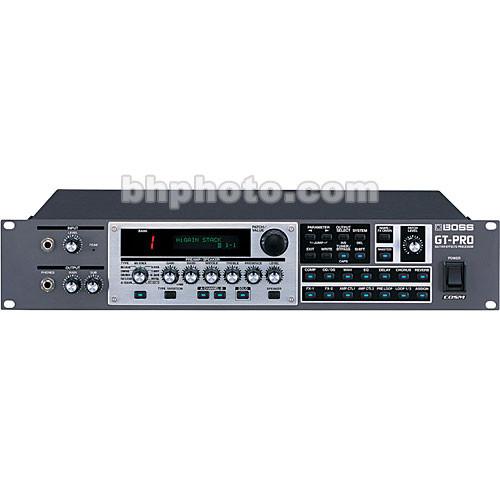
Over the past two decades of my musical journey, I have dabbled in various devices and setups to achieve just the right audio aesthetics. In my quest for the perfect guitar tone, the rack effects have always held an unwavering significance. When I began my stint with the esteemed Guitar Player magazine, rack effects were in full swing. Their vibrancy, the sonic versatility they provided instantly swept me off my feet. However, with the meteoric rise of digital effects and plugins, today’s modern guitarists find themselves at a crossroads.
In an age heavily dominated by digital effects and plugins, where do guitar rack effects stand? Are they still worth considering? To answer these questions, we must delve deeper into the stronghold of rack effects and carry forth a comparative discussion.
Over my years of testing and experimenting, I’ve come to appreciate the nuance and depth characterizing different types of effects. Each has its appeal, but there’s a unique warmth and depth inherent in analog gear that digital can’t seem to fully replicate. There’s something magical about dialing in the perfect combination of effects on a rack mount, and letting rip some ferocious licks or soulful chord sequences.
Understandably, digital delays and dynamic range of reverb processors bring unmatched precision and versatility, which has led to their widespread popularity. But, that doesn’t diminish the fact that guitar rack effects have a distinct place of their own. They allow guitarists to explore virtually endless customizations and permutations of guitar tones—a terrain that digital effects only touch the surface of.
You see, rack effects provide an unmatched depth and richness to your sound that pedals or virtual effects often miss. Their full potential is often overlooked, but when tapped into, can yield surprising and extraordinary results. This is true regardless if you’re playing in a home studio, live on stage, or even just jamming in your living room.
While digital devices and software offer efficiency and ease of use, they can at times create a disconnect between the musician and the music. The physical interaction with a rack effect, turning the knobs, tweaking the EQ, feeling the hum and warm glow of the tubes—it’s a tangible, visceral experience that’s genuinely special and one that digital can never truly emulate.
Staying relevant in our digital age has never been more challenging, but through my years of exploring these nuanced aspects, I firmly believe in the longevity and relevance of guitar rack effects. So, whether you’re a novice or a seasoned music aficionado, rack effects are definitely still worth considering, and exploring their potential can be an exciting and rewarding addition to your sonic journey.
As we continue our comprehensive exploration of guitar rack effects, let’s delve into the various popular rack effects and their distinctive characteristics in the spotlight section. We conclude with a comprehensive buying guide to help you choose the right rack effects, further highlighting their enduring significance in the world of guitars.
Rack Effects Buying Guide

With so many options on the market, buying new guitar gear can be a daunting task. But much like how each individual note is crucial in creating a beautiful melody, every piece of your gear plays an integral role in shaping your distinct sound. My professional life has been deeply entrenched in the music scene, giving advice through interviews, articles, and guitar events. It’s these priceless experiences that I will be sharing with all of you today, in the hopes of providing a comprehensive buying guide for rack effects.
Are you in the market to enhance your gear? If you’re confused about what to look for, let’s unravel the key factors you need to consider when buying guitar rack effects. This is not a one-size-fits-all situation; each musician will have unique needs and preferences. My main goal in this guide is not to give you an exact checklist to follow blindly but rather to equip you with the necessary knowledge to make an informed purchase, tailored specifically to your style and sound.
One of the first things I always tell musicians is: don’t go for the effects rack bargain just because it’s cheaper. A bargain may seem tempting, but it might not serve you well in the long run. Always prioritize quality before price. If you’re on a budget, take the time to research and find a product with positive reviews and a solid reputation within your price range. Also, remember to consider the long-term maintenance costs in your budget.
Next, be clear about where you’ll be using your rack effects. Will you be using it mainly in a studio, on live performances, or both? This is crucial as some effects may sound astounding in the studio but may not translate well in a live setting and vice versa.
Another key factor is the ease of use. In my experience, some rack effects have enormous potentials but are also incredibly difficult to navigate. Especially if you’re not familiar with the terminology, a complex interface may impose unnecessary challenges. So, as much as it’s crucial to choose something that caters to your needs, do not underestimate usability.
Lastly, consider the size and weight. A giant rack effect may promise numerous functionalities, but it might also be more cumbersome to transport. So, if you’re a musician who often travels, a lighter and smaller device could be more suitable.
As you check off the key factors, you will naturally start to form a clearer idea of what you want from a rack effects unit. In this journey, it’s always great to refer to rack effects guides, but remember, no guide can replace personal experience. If possible, try the product out firsthand before making the purchase. This way, you can personally assess the sound, quality, and usability in real-time.
Buyer’s remorse is a real threat, particularly when investing in musical gear. However, with time, patience, and a little effort in research and testing, you can secure the perfect rack effects unit for your particular needs. As a guiding principle, always remember that the perfect equipment for you is the one that delivers the sound you love and complements your musical vision.
To wrap this up, I would like to remind you that as you immerse yourself in this process, it is not just about the gears; it’s about your music. Keep your passion aflame and continue creating. The best tech can only amplify the talent you already possess.
FAQs
What are guitar rack effects?
What are the different types of guitar rack effects?
How to set up a guitar rack effects?
Which is better: pedal effects or rack effects?
Conclusion
In concluding this comprehensive guide, I want to underscore the profound influence guitar rack effects can have on your music, shaping your sound beyond the scope of the guitar itself. Throughout my career, my passion for the guitar and its many forms of expression has guided my understanding of these versatile devices. My hope is that my insights will fuel your own musical journey.
Whether it’s history, usage, setup, live performance, comparison with pedals, or the current relevance of rack effects—every aspect is deeply connected and essential for a well-rounded viewpoint. Remember, the advantages and the potential drawbacks of rack effects and pedals should inform your decision based on your individual needs and style.
The world of guitar rack effects is vast, with a plethora of popular effects to explore. The role these devices still play in shaping modern music underscores their continued relevance. Shopping for these devices can be challenging, given numerous factors at play. But armed with the insights from this guide, you’re now better prepared to navigate those decisions.
In the end, the choice indeed remains a personal one—a reflection of your style, your influences, and your sonic ambitions. But what remains certain is the transformative role of guitar rack effects in unlocking new dimensions of musical exploration. This guide marks a starting point, a launching pad for your sonic adventures. Now, it’s your turn to explore, experiment, and express through the limitless potential of guitar music.